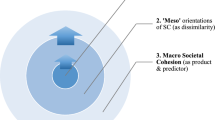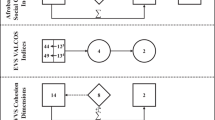Abstract
In spite of its currency both in academic research and political rhetoric, there are numerous attempts to define and conceptualize the social cohesion concept but there has been paid little attention to provide a rigorous and empirically tested definition. There are even fewer studies that address social cohesion in a framework of cross-cultural validation of the indicators testing the equivalence of the factorial structure across countries. Finally, as far as we know there is no study that attempt to provide an empirically tested multilevel definition of social cohesion specifying a Multilevel Structural Equation Model. This study aims to cover this gap. First, we provide a theoretical construct of social cohesion taking into account not only its multidimensionality but also its multilevel structure. In the second step, to test the validity of this theoretical construct, we perform a multilevel confirmatory factor analysis in order to verify if the conceptual structure suggested in first step holds. In addition, we test the cross-level structural equivalence and the measurement invariance of the model in order to verify if the same multilevel model of social cohesion holds across the 29 countries analysed. In the final step, we specify a second-order multilevel CFA model in order to identify the existence of a general factor that can be called “social cohesion” operating in society that accounts for the surface phenomena that we observe.


Similar content being viewed by others
Notes
The questionnaire is available at http://www.europeansocialsurvey.org/.
Additional information is available at http://www.europeansocialsurvey.org/methodology/translation.html.
In a MCFA the within item intercepts are allowed to be random at between-level. The within item intercepts become dependent variables at level-2.
A researcher should constrain to zero the residual variances close to zero, but in our first model we preferred to keep freely estimated the residual variances to evaluate the magnitude of these variances. In the model 2, we have constrained the negative residual variances to zero.
The Chi-square value for model-2 decreases compared with the chi-square value for model 1 (Table 4). Generally, it should be the contrary because in model 2 we have constrained the loadings to be equal across levels gaining degree of freedom. In this case, with the WLSMV estimator, it could happen that a model with more df shows a lower chi-square value. This because WLSMV produces a chi-square adjusted to the means and variances, and adjustment depends not only on data but also on the models (Muthén and Muthén 1998–2012).
Measurement invariance is an important issue in cross-cultural research because several problems can arise (translation problems, cultural biases, etc.). In addition, the measurement invariance of an instrument across groups is a necessary condition in order to compare groups with respect to the latent variables measured by that instrument (Jak et al. 2013).
The model-3 is nested in model-2 that in turn is nested in model-1. In these cases, a researcher can perform the chi-square difference test. Mplus with WLSMV estimator requires a special procedure called DIFFTEST. However, we cannot perform a chi-square difference test neither inspect the modification indices searching for misfit areas because they are not still available with WLSMV estimator in Mplus 7 for multilevel data.
In order to run the model we had to leave out the dichotomous variable “b13”. It showed extremely huge standard error caused by computation problem.
References
Adamopoulos, J. (2008). On the entanglement of culture and individual behavior. In F. J. Van de Vijver, D. A. Van Hemert, & Y. H. Poortinga (Eds.), Multilevel analysis of individuals and cultures (pp. 27–62). Mahwah: Lawrence Erlbaum Associates.
Asparouhov, T., & Muthen, B. (2007). Computationally efficient estimation of multilevel high-dimensional latent variable models. In Proceedings of the 2007 JSM meeting in Salt Lake City, Utah, Section on Statistics in Epidemiology (pp. 2531–2535).
Beauvais, C., & Jenson, J. (2002). Social cohesion: Updating the state of the research. CPRN Discussion Paper No. F|22 (Canadian Policy Research Networks, Ottawa).
Bentler, P. M. (1992). On the fit of models to covariances and methodology to the Bulletin. Psychological Bulletin, 112(3), 400.
Berger-Schmitt, R. (2000). Social cohesion as an aspect of the quality of societies: concept and measurement. Eureporting Working Paper no 14 (Centre for Survey Research and Methodology, Mannheim).
Berger-Schmitt, R. (2002). Considering social cohesion in quality of life assessments: Concept and measurement. Social Indicators Research, 58, 403–428.
Bernard, P. (1999). Social cohesion: A dialectical critique of a quasi-concept. Paper SRA-491, Ottawa: Strategic Research and Analysis Directorate. Department of Canadian Heritage.
Bollen, K. A., & Hoyle, R. H. (1990). Perceived cohesion: A conceptual and empirical examination. Social forces, 69(2), 479–504.
Byrne, B. M., & van De Vijver, F. J. (2010). Testing for measurement and structural equivalence in large-scale cross-cultural studies: Addressing the issue of nonequivalence. International Journal of Testing, 10(2), 107–132.
Chan, J., To, H. P., & Chan, E. (2006). Reconsidering social cohesion: Developing a definition and analytical framework for empirical research. Social Indicators Research, 75(2), 273–302.
Cheung, M. W. L., & Au, K. (2005). Applications of multilevel structural equation modeling to cross-cultural research. Structural Equation Modeling, 12(4), 598–619.
Cieciuch, J., Davidov, E., Schmidt, P., Algesheimer, R., & Schwartz, S. H. (2014). Comparing results of an exact vs. an approximate (Bayesian) measurement invariance test: A cross-country illustration with a scale to measure 19 human values. Frontiers in Psychology, 5, 982. doi:10.3389/fpsyg.2014.00982.
Davidov, E., Dülmer, H., Schlüter, E., Schmidt, P., & Meuleman, B. (2012). Using a multilevel structural equation modeling approach to explain cross-cultural measurement noninvariance. Journal of Cross-Cultural Psychology, 43(4), 558–575.
Davidov, E., Meuleman, B., Cieciuch, J., Schmidt, P., & Billiet, J. (2014). Measurement equivalence in cross-national research. Annual Review of Sociology, 40, 55–75.
Dickes, P., & Valentova, M. (2013). Construction, validation and application of the measurement of social cohesion in 47 European countries and regions. Social Indicators Research, 113(3), 827–846.
Dickes, P., Valentova, M., & Borsenberger, M. (2010). Construct validation and application of a common measure of social cohesion in 33 European countries. Social Indicators Research, 98(3), 451–473.
Duhaime, G., Searles, E., Usher, P. J., Myers, H., & Frechette, P. (2004). Social cohesion and living conditions in the Canadian Arctic: From theory to measurement. Social Indicators Research, 66(3), 295–318.
Durkheim, E. (1893). De la division du travail social: étude sur l’organisation des sociétés supérieures. Paris: Presses Universitaires de France.
Fontaine, J. R. (2008). Traditional and multilevel approaches in cross-cultural research: An integration of methodological frameworks. In F. J. Van de Vijver, D. A. Van Hemert, & Y. H. Poortinga (Eds.), Multilevel analysis of individuals and cultures (pp. 65–92). Mahwah: Lawrence Erlbaum Associates.
Friedkin, N. E. (2004). Social cohesion. Annual Review of Sociology, 30, 409–425.
Hox, J. (2010). Multilevel analysis: Techniques and applications. Abingdon: Routledge.
Hox, J. (2013). Multilevel regression and multilevel structural equation modeling. In T. D. Little (Ed.), The Oxford handbook of quantitative methods in psychology (Vol. 2, pp. 281–294). Oxford: Oxford University Press.
Hu, L. T., & Bentler, P. M. (1999). Cutoff criteria for fit indexes in covariance structure analysis: Conventional criteria versus new alternatives. Structural Equation Modeling: A Multidisciplinary Journal, 6(1), 1–55.
Jak, S., Oort, F. J., & Dolan, C. V. (2013). A test for cluster bias: Detecting violations of measurement invariance across clusters in multilevel data. Structural Equation Modeling: A Multidisciplinary Journal, 20(2), 265–282.
Jeannotte, M. S. (2003). Social cohesion: Insights from Canadian research. Gatineau: Department of Canadian Heritage.
Jenson, J. (1998). Mapping social cohesion: The state of Canadian research. Paper SRA-321, Family Network, Canadian Policy Research Networks Inc.
Jöreskog, K. G. (1999). How large can a standardized coefficient be?. The help-file of the LISREL program.
Jöreskog, K. G., & Sörbom, D. (1993). LISREL 8: Structural equation modeling with the SIMPLIS command language. Scientific Software International.
Lockwood, D. (1999). Civic integration and social cohesion. In I. Gough (Ed.), Capitalism and social cohesion (pp. 63–84). London: Palgrave Macmillan.
MacCallum, R. C., Browne, M. W., & Sugawara, H. M. (1996). Power analysis and determination of sample size for covariance structure modeling. Psychological Methods, 1(2), 130.
Mehta, P. D., & Neale, M. C. (2005). People are variables too: Multilevel structural equations modeling. Psychological Methods, 10(3), 259.
Meredith, W. (1993). Measurement invariance, factor analysis and factorial invariance. Psychometrika, 58(4), 525–543.
Muthén, B. (1984). A general structural equation model with dichotomous, ordered, categorical and continuous latent variable indicators. Psychometrika, 49(1), 115–132.
Muthén, B. (1990). Mean and covariance structure analysis of hierarchical data. Los Angeles, CA: UCLA.
Muthén, B. O. (1991). Multilevel factor analysis of class and student achievement components. Journal of Educational Measurement, 28(4), 338–354.
Muthén, B. O. (1994). Multilevel covariance structure analysis. Sociological Methods & Research, 22(3), 376–398.
Muthén, B. O., & Muthén, L. K. (1998–2012). Mplus user’s guide. Los Angeles, CA: Muthén & Muthén.
Noll, H. H. (2002). Towards a European system of social indicators: Theoretical framework and system architecture. Social Indicators Research, 58(1–3), 47–87.
Parsons, T. (1949). The structure of social action (Vol. 491). New York: Free Press.
Preacher, K. J., Zyphur, M. J., & Zhang, Z. (2010). A general multilevel SEM framework for assessing multilevel mediation. Psychological Methods, 15(3), 209.
Rabe-Hesketh, S., Skrondal, A., & Pickles, A. (2004). Generalized multilevel structural equation modeling. Psychometrika, 69(2), 167–190.
Rajulton, F., Ravanera, Z. R., & Beaujot, R. (2007). Measuring social cohesion: An experiment using the Canadian national survey of giving, volunteering, and participating. Social Indicators Research, 80(3), 461–492.
Raudenbush, S. W., & Bryk, A. S. (2002). Hierarchical linear models: Applications and data analysis methods (2nd ed.). Newbury Park, CA: Sage.
Selig, J. P., Card, N. A., & Little, T. D. (2008). Latent variable structural equation modeling in cross-cultural research: Multigroup and multilevel approaches. In F. J. Van de Vijver, D. A. Van Hemert, & Y. H. Poortinga (Eds.), Multilevel analysis of individuals and cultures (pp. 93–119). Mahwah: Lawrence Erlbaum Associates.
Snijder, T., & Bosker, R. (1999). Multilevel analysis. An introduction to basic and advanced modelling. London: SAGE Publications.
Steiger, J. H., & Lind, J. C. (1980). Statistically based tests for the number of common factors. In Annual meeting of the Psychometric Society, Iowa City, IA (Vol. 758).
Whelan, C. T., & Maître, B. (2005). Economic vulnerability, multidimensional deprivation and social cohesion in an enlarged European community. International Journal of Comparative Sociology, 46(3), 215–239.
Author information
Authors and Affiliations
Corresponding author
Rights and permissions
About this article
Cite this article
Bottoni, G. A Multilevel Measurement Model of Social Cohesion. Soc Indic Res 136, 835–857 (2018). https://doi.org/10.1007/s11205-016-1470-7
Accepted:
Published:
Issue Date:
DOI: https://doi.org/10.1007/s11205-016-1470-7




